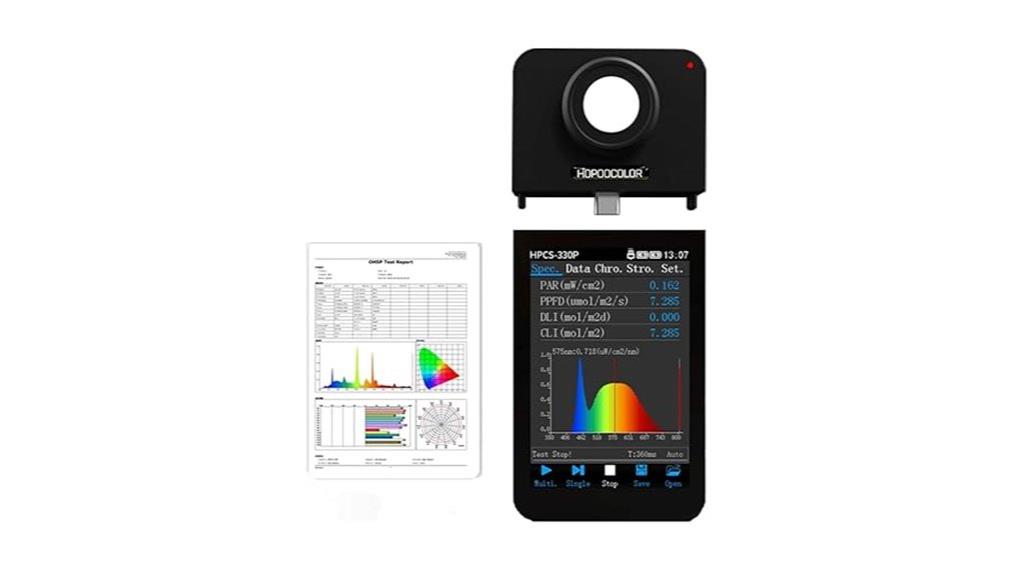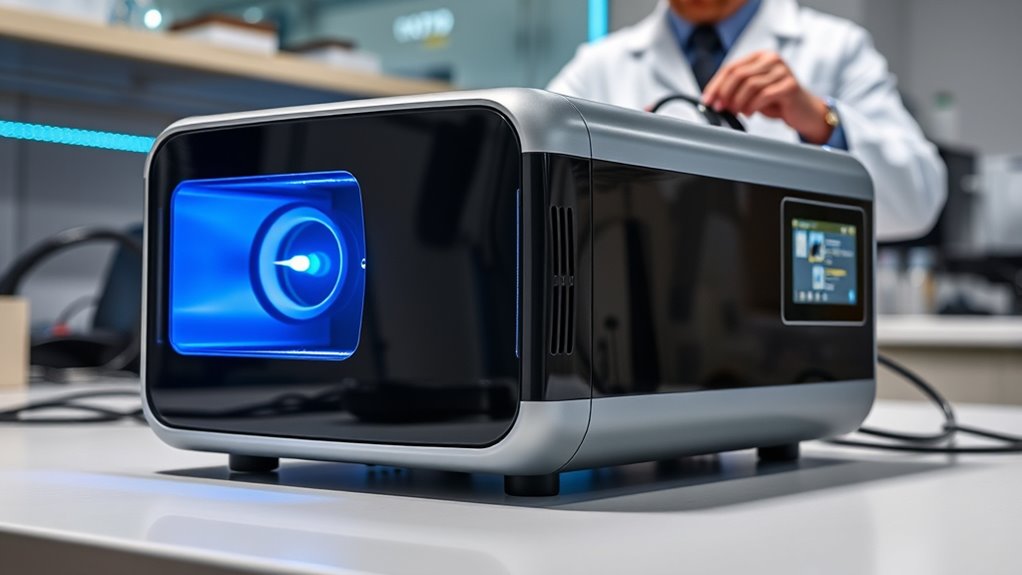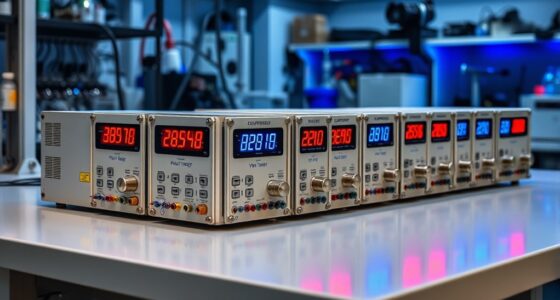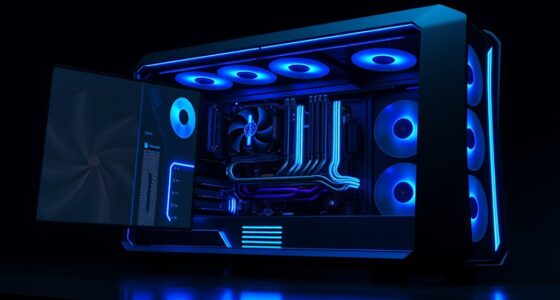In 2025, the top Raman spectrometers are those that combine high sensitivity, broad spectral coverage, and rugged durability for reliable performance across industries. I recommend models that are compact, easy to operate, and equipped with wireless connectivity to guarantee seamless data transfer. These devices also feature sturdy build quality for tough environments. If you’re curious about which models lead the way this year, there’s more to explore that can help you make an informed choice.
Key Takeaways
- Top models offer high spectral sensitivity, broad measurement ranges, and excellent signal-to-noise ratios for precise analysis.
- Industry-leading spectrometers feature rugged, sealed designs with environmental protection for reliable outdoor and industrial use.
- Compact, portable units with wireless connectivity and user-friendly interfaces enable efficient field deployment and data management.
- Premium instruments combine durability with low maintenance, ensuring long-term calibration stability and consistent performance.
- The best options balance advanced performance with affordability, supporting diverse applications with industry-leading accuracy.
HPCS-330P Spectrometer PPFD Meter PAR Quantum Meter Wireless Bluetooth Connection

The HPCS-330P Spectrometer PPFD Meter PAR Quantum Meter is an excellent choice for professionals and hobbyists who need a portable, easy-to-use device for light measurement. Its wireless Bluetooth connection lets you detach the sensor for flexible positioning, perfect for tight or remote spaces. The compact design fits easily into bags or pockets, making it ideal for on-the-go testing. It measures key light parameters like PPFD, PAR, lux, CCT, and CRI with high accuracy across a wavelength range of 350 to 800 nm. You can save data directly on the device and export it as Excel files, streamlining analysis and reporting.
Best For: growers, horticulturists, and lighting professionals seeking a portable, accurate, and versatile light measurement tool for on-the-go testing and detailed analysis.
Pros:
- Wireless Bluetooth connectivity with sensor detachment for flexible use
- Compact, lightweight design ideal for portable and remote testing environments
- Supports comprehensive data management with direct saving and export to Excel
Cons:
- Limited wavelength range from 350 to 800 nm, excluding UV and IR spectrums
- Requires compatible Windows PC software for detailed reporting, which may not be available for other operating systems
- Battery life and charging details are not specified, potentially affecting prolonged use
YSI Pro 10 pH/ORP/Temperature Portable Meter

If you’re seeking a reliable, versatile portable meter for field or lab use, the YSI Pro 10 pH/ORP/Temperature Portable Meter stands out with its rugged IP67 waterproof design. It features a clear graphic backlit LCD display, a glow-in-the-dark keypad, and stores up to 50 data sets internally. The device measures pH, ORP, and temperature with high accuracy and automatic temperature compensation. Compatible with various probes and cables, it adapts to different environments. Its durable construction, military-spec connectors, and a three-year warranty make it ideal for demanding testing scenarios. This meter combines precision, durability, and ease of use in a compact, portable package.
Best For: professionals and researchers needing a durable, accurate portable meter for field or laboratory testing of pH, ORP, and temperature.
Pros:
- Rugged IP67 waterproof design suitable for tough environments
- Stores up to 50 data sets for efficient data management
- High accuracy with automatic temperature compensation and multi-language display
Cons:
- May require specific probes and cables for different applications, adding to initial setup costs
- Larger size compared to some handheld meters could impact portability in tight spaces
- Limited to 3-year warranty, which may be shorter than some competitors
Factors to Consider When Choosing Raman Spectrometers

When selecting a Raman spectrometer, I focus on key factors like measurement range, sensitivity, and portability to guarantee it fits my specific needs. I also consider data management, compatibility with other devices, and how easy it is to operate. These points help me choose a model that’s both effective and user-friendly.
Measurement Range and Sensitivity
Choosing a Raman spectrometer requires careful attention to its measurement range and sensitivity to make certain it meets your specific needs. Guarantee the device covers the relevant wavelengths and signal intensities of your samples, so you capture all essential spectral features. Higher sensitivity is vital for detecting low-concentration substances and subtle signals that might otherwise go unnoticed. The device’s signal-to-noise ratio determines how well it can distinguish weak Raman signals from background noise. Calibration and resolution specs define the smallest detectable signal changes and measurement precision. Additionally, a broad dynamic range allows the spectrometer to accurately record both strong and weak signals simultaneously. Prioritizing these factors ensures you’re equipped with a precise, reliable instrument suited to your analytical requirements.
Portability and Size
Portability and size are critical factors when selecting a Raman spectrometer, especially for applications that require mobility or on-site analysis. Compact designs, typically under 30 cm long, make them easy to transport and deploy quickly. Lightweight models, weighing less than 2 kg, are ideal for fieldwork, reducing fatigue during extended use. Detachable components, like handheld probes or sensors, add flexibility and help access hard-to-reach areas. Battery-powered units enable measurements in remote locations without relying on external power sources, enhancing versatility. The overall size and form factor directly influence how easily you can store, carry, and set up the instrument in various environments. Smaller, portable spectrometers are essential for rapid response, field surveys, and on-site quality control.
Data Management Features
Effective data management is essential for maximizing the utility of Raman spectrometers, especially in busy laboratory or field settings. I look for devices that can store numerous measurements internally, often from dozens to thousands of data points, ensuring thorough data capture. Export options like Excel, CSV, or PDF are critical for seamless analysis and reporting, saving time and reducing errors. Wireless connectivity, such as Bluetooth or Wi-Fi, allows for real-time data transfer to external devices, facilitating remote monitoring and immediate access. Integrated software compatibility supports detailed data analysis, visualization, and report generation directly from the device or via PC applications. Additionally, robust data security features like password protection and encrypted storage protect sensitive measurement data from unauthorized access.
Compatibility and Connectivity
When selecting a Raman spectrometer, ensuring it has compatible connectivity options like USB, Wi-Fi, or Bluetooth is vital for smooth data transfer and remote operation. These features allow me to transfer results efficiently and control the device from a distance, saving time. I also check if the device can integrate with my existing lab or field equipment to streamline workflows. Software compatibility with my operating system, whether Windows or macOS, is essential for analysis and reporting. Wireless connectivity is a bonus, especially for detaching sensors and taking measurements in tight or hard-to-reach spots. Finally, I verify if the spectrometer can export data in standard formats like Excel or CSV, making it easier to analyze, share, and archive results without hassle.
Ease of Use
Choosing a Raman spectrometer that’s easy to operate can make a significant difference in your workflow. An intuitive interface with clear menus and controls helps new users get started quickly, reducing the learning curve. Automated calibration and preset measurement protocols simplify operation and minimize user errors. A compact, lightweight design enhances portability, making it easier to handle in both field and lab settings. Wireless options like Bluetooth or Wi-Fi facilitate seamless data transfer and remote operation, saving time. Additionally, a clear, real-time display of measurement results and step-by-step guidance improves the user experience and measurement accuracy. When selecting a spectrometer, prioritize those features to ensure smooth, efficient, and reliable operation every time you need precise results.
Durability and Build Quality
Durability and build quality are critical factors in selecting a Raman spectrometer, especially if you’ll be using it in challenging environments. I look for models with robust construction, such as rubberized or metal housings, to withstand tough conditions. Water and dust resistance ratings like IP65 or higher are essential for outdoor or industrial applications, ensuring protection against environmental contaminants. Impact-resistant materials and shock-absorbing designs help prevent damage from accidental drops or rough handling, maintaining the device’s accuracy over time. A rugged build also supports consistent calibration and reliable performance during prolonged use. Additionally, sealed connectors and protective covers for optical components minimize exposure to dust and moisture, substantially extending the instrument’s longevity and operational integrity in demanding settings.
Cost and Budget
Selecting the right Raman spectrometer involves more than just its durability; budget considerations play a significant role in narrowing down options. Raman systems can range from a few thousand dollars for basic models to over $100,000 for advanced, high-resolution setups. It’s important to include not only the initial purchase cost but also ongoing expenses like maintenance, calibration, and accessories. Lower-cost models may sacrifice spectral resolution, sensitivity, or wavelength range, which can impact measurement accuracy and suitability for specific applications. When evaluating options, I recommend weighing long-term value against your needs. A more expensive instrument might offer better reliability and capabilities, but if your requirements are simpler, a budget-friendly device could suffice. Ultimately, balancing cost with performance ensures you get the best value.
Frequently Asked Questions
What Are the Maintenance Requirements for Top Raman Spectrometers?
Maintaining top Raman spectrometers involves regular calibration, cleaning the optical components, and checking the laser alignment. I also recommend inspecting the sample holder and ensuring the software is up to date. Daily, I wipe down the optics and ensure the cooling systems are functioning properly. Periodically, I perform thorough system diagnostics and replace any worn parts to keep the spectrometer running at peak performance.
How Do Raman Spectrometers Compare With Other Spectroscopic Techniques?
Oh, sure, Raman spectrometers are just the shiny new toys, right? Actually, they excel in identifying molecular structures with minimal sample prep, unlike IR or UV-Vis, which can be more cumbersome or less specific. Raman’s ability to analyze samples non-destructively and in situ makes it a top choice. So, if you want quick, accurate results, Raman spectroscopy often outperforms other techniques, especially in complex or sensitive samples.
Are There Portable Raman Spectrometers Suitable for Fieldwork?
Absolutely, there are portable Raman spectrometers perfect for fieldwork. I’ve used some that are lightweight, easy to operate, and deliver quick, accurate results right on-site. They’re ideal for applications like mineral analysis, forensics, and quality control outside the lab. These devices often feature rechargeable batteries and rugged designs, making them reliable tools when you’re out in the field, away from traditional lab setups.
What Is the Typical Lifespan of a High-End Raman Spectrometer?
A high-end Raman spectrometer typically lasts around 10 to 15 years with proper maintenance. I’ve found that longevity depends heavily on consistent calibration, careful handling, and timely upgrades. Regularly servicing the device keeps it performing precisely and reliably, ensuring it remains an essential instrument in my lab or fieldwork. So, if you treat it well, your spectrometer can provide years of accurate analysis, making it a valuable investment.
How Do Software Updates Impact Raman Spectrometer Performance?
Software updates greatly impact a Raman spectrometer’s performance by improving accuracy, enhancing features, and fixing bugs. I’ve found that staying current with updates guarantees reliable results and keeps the device optimized for new challenges. Updates can also add compatibility with other instruments and expand analytical capabilities. Regular updates are essential for maintaining peak performance and extending the lifespan of the spectrometer, giving me confidence in my data quality.
Conclusion
Choosing the right Raman spectrometer feels like finding the perfect compass for your scientific journey—essential and guiding. Whether you prioritize precision or portability, these top picks lead the way into 2025 with industry-leading reliability. Remember, the best device isn’t just about specs; it’s about how well it fits your needs. So, equip yourself wisely—because in this field, a great tool can truly be your North Star.









